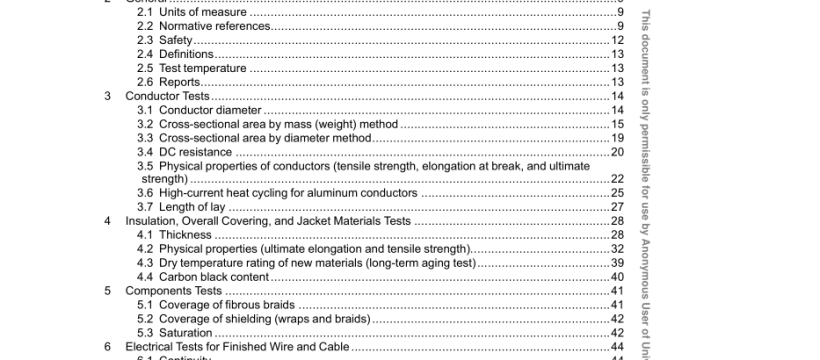UL 25A-2019 pdf download.Meters for Gasoline and Gasoline/ Ethanol Blends with Nominal Ethanol . Concentrations up to 85 Percent (E0一 E85).
6.1.2.1.2 A coating or plating, applied to a base metal, shall be resistant to the action of the fuels anticipated by these requirements as determined by the Long Term Exposure Test, Section 12. 6.1.2.2 Atmospheric corrosion 6.1.2.2.1 Metalic materials used for fluid confining parts shall be resistant to atmospheric corrosion. In addition, metallic materials that are required to operate to address safety shall be resistant to atmospheric corrosion. Ferrous materials of a thickness specified in the following items are acceptable for the preceding when uncoated: a) A casting having a wall thickness of not less than 1/4 inch (6.4 mm) if shown by production test to be free of leakage; b) Standard pipe and fttings conforming to the Standard for Welded and Seamless Wrought Steel Pipe, ANSI/ASME B36. 10M; and c) Fabricated sheet steel parts having a minimum wall thickness of 0.093 inch (2.36 mm). 6.1.2.2.2 A protective coating shall provide resistance against atmospheric corrosion to a degree not less than that provided by the protective coatings specifed in 6.1.2.2.3.
6.1.2.2.3 Cadmium plating shall not be less than 0.0003 inch (0.008 mm) thick, and zinc plating shall not be less than 0.0005 inch (0.013 mm) thick, except on parts where threads constitute the major portion of the area in which case the cadmium or zinc plating shall not be less than 0.00015 inch (0.0038 mm) thick. Metallic parts are considered to comply with 6.1.2.2 when they are protected against atmospheric corrosion by: a) Hot dipped, mill galvanized sheet steel complying with the coating designation G90 in Table I of the Specification for Sheet Steel, Zinc Coated (Galvanized) or Zinc-lron-Alloy Coated (Galvannealed) by the Hot Dip Process, ASTM A653/A653M, or b) Coatings which have been determined to be equivalent to G90 under the requirements of the Standard for Organic Coatings for Steel Enclosures for Outdoor Use Electrical Equipment, UL 1332. 6.1.2.2.4 A metallic material other than as described in 6.1.2.2.1 – 6.1.2.2.3 shall be painted or protected in a manner that has been determined to be equivalent. 6.1.3 Metallic materials – system level 6.1.3.1 Combinations of metallic materials in products rated for use with gasoline/ethanol blends with nominal ethanol concentrations greater than 40 percent shall be chosen to reduce degradation due to galvanic corrosion in accordance with 6.1.3.2- 6.1.3.4. 6.1.3.2 Table 6.1 shows the galvanic series for metallic materials exposed to a conductive solution of sea water. The most active material in a given combination will experience increased levels of corrosion, while the most passive material in the combination will experience reduced levels of corrosion. The greater the separation of the materials in the galvanic series of Table 6.1, the more pronounced the effects would be. Table 6.1 serves as a guide in selecting the appropriate test conditions based on manufacturer specified material combinations.
6.2.2.1.4 Static seals shall be subjected to the Compression Set Test in accordance with the Standard for Gaskets and Seals, UL 157, except for the fllowing modifications: a) The test duration shall be 1000 hours; b) The samples shall be immersed, at room temperature, in the test fluids (see item c) while compressed for the entire test duration. No oven conditioning is required. c) The applicable test fluids shall be as described in Supplement SA. d) The recovery period shall consist of removing the sample from the compression device and immersing it in the applicable test fluid for 30 minutes at room temperature. The sample shall not be allowed to dry out due to exposure to air. The 30 minute immersion should use the same fluid as the test fluid for each sample. e) For all materials, the average compression set is calculated and shall not exceed 35 percent. For coated fabrics, alternate limits can be used with the average compression set not exceeding 70%. Exception: This requirement does not apply to composite gasket materials as defined in accordance with the Standard for Gaskets and Seals, UL 157. 6.2.2.2 Dynamic seals 6.2.2.2.1 Dynamic seals shall be evaluated in accordance with the Standard for Gaskets and Seals, UL 157, modified as indicated in 6.2.2.2.2 – 6.2.2.2.4. If a specific material complies with these requirements, the material can be considered to be qualified for system level testing. 6.2.2.2.2 A dynamic seal shall be constructed of a material that is acceptable in accordance with the scope of the Standard for Gaskets and Seals, UL 157.UL 25A-2019 pdf download.
UL 25A-2019 pdf download
